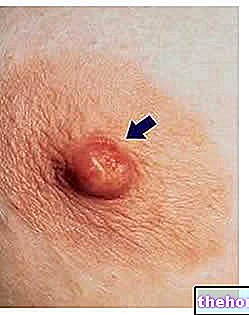Definition of galactorrhea
Galactorrhea indicates a serous or milky discharge from one nipple (or both), which occurs in the woman outside the lactation period (non-puerperal galactorrhea). This anomalous milky secretion, typical of galactorrhea, appears very similar to colostrum (the "first milk" produced by the mammary glands in the "immediate post partum").
Incidence
Galactorrhea is physiological when the milk secretion continues, in the nursing mother, in the months following the birth: the breast serous loss could occur following a squeezing of the nipple, but also spontaneously.

The milky secretions can be of different entity: some women complain of an abundant and copious production similar to milk, even a few years after giving birth, even if they do not present any pathology. For other women, on the other hand, the milky secretion from the nipple is modest and can be evoked by the mere squeezing of the breast.
Considering that about 10% of breast cancers begin with nipple discharge, it is good practice to consult a doctor from the first symptoms, obviously excluding breastfeeding women.
Although galactorrhea is considered an exclusively female phenomenon, the disorder has also been found in some men (an almost rare condition): in the male galactorrhea manifests itself not only with milky discharge from the nipples, but is frequently accompanied by headache, decreased libido, possible impotence and blurred vision.
Related ailments
Galactorrhea can sometimes be confused with mammary secretions of a different nature (purulent, blood discharge) that do not reflect endocrine modulations and that deserve a more thorough "medical examination."
Galactorrhea is often found in women with amenorrhea, hyperprolactinemia, hypothyroidism, dyspareunia, infertility, oligomenorrhea, pituitary tumors and hyperandrogenism.
Classification
Based on the way in which the milky substance is secreted, galactorrhea can be defined intermittent or continues, spontaneous or induced (from squeezing the nipple), e bilateral od unilateral.
Furthermore, it is appropriate to distinguish galactorrhea associated with amenorrhea from galactorrhea that occurs in women with regular menstruation: the etiological research and the consequent solution therapy are in fact different. From medical statistics, it emerges that 80% of women with galactorrhea also suffer from significant menstrual delays (galactorrhea amenorrhea syndrome); when galactorrhea occurs concomitantly with amenorrhea, the woman is probably also affected by hyperprolactinemia and / or hypothyroidism.
In cases where galactorrhea occurs without consistent menstrual irregularities, the milky secretions from the nipples are usually due to the intake of drugs (tricyclic antidepressants, opioids, birth control pills, neuroleptic drugs - eg phenothiazines, antihistamines, cimetidine, some antihypertensives), associated with stressful conditions and alterations in prolactin values.
It is estimated that hyperprolactinemia occurs in 30% of women with galactorrhea; in these cases, we speak of hyperprolactinaemic galactorrhea, which may or may not be related to "thyroid insufficiency. The increase in prolactin causes galactorrhea, but it could also cause menstrual disturbances and, in severe cases, infertility. Galactorrhea is the first alarm bell for an alteration in the synthesis of prolactin, which can also occur independently of the variation in hormonal levels in the blood; otherwise, it has been estimated that only 16.5% of women with hyperprolactinemia also suffer from galactorrhea (in other numbers and in other words, one in 6 women with hyperprolactinemia has abnormal milky secretions from the breasts). [Treatise on functional endocrinological diagnostics, D. Andreani, G. Menzinger, D. Andrean].
The milky secretions typical of galactorrhea can be stopped by correcting the value of the altered hormones in the blood.
In the aforementioned cases of galactorrhea induced by pharmacological / hormonal therapies, there was an increase in prolactimenia: this evidence highlights how much prolactin values can affect the manifestation of galactorrhea.
Amenorrhea galactorrhea syndrome
We have seen that galactorrhea is often correlated with amenorrhea (amenorrhea-galactorrhea syndrome): in this regard, three sub-categories have been classified, corresponding, in turn, to other syndromes.
- In Forbes-Albright syndrome, the galactorrhoea-amenorrhea association is favored by a pituitary adenoma known as a chromophobic adenoma;
- In Chiari-Frommel syndrome, galactorrhea and amenorrhea persist even many months after pregnancy;
- Ahumada-del Castillo syndrome involves the connection between the two disorders (amenorrhea, galactorrhea) regardless of pregnancy.
Diagnosis and therapies
Considering that the level of prolactin has a significant influence on galactorrhea, it is understandable that the dosage of the hormone is of fundamental diagnostic importance; moreover, it is advisable to carry out an investigation on the dosage of free thyroid hormones and on the thyroid stimulating hormone (TSH).
The therapy of galactorrhea consists in the removal of the triggering factors, for which the hormonal balance is essential; however, even the administration of dopaminergic drugs could correct the hyperprolactinemia, consequently resolving the galactorrhea.
Summary
To fix the concepts ...
Galactorrhea
Description
A serous or milky discharge from one nipple (or both), which occurs in the woman outside the breastfeeding period (non-puerperal galactorrhea)
Physiological galactorrhea
Galactorrhea is physiological when milk secretion continues in the nursing mother in the months following delivery
Incidence
Predominantly female, but male exceptions are not lacking
Galactorrhea in man
Milky discharge from the nipples, frequent headache, decreased libido, possible impotence and blurred vision
Related diseases
Amenorrhea, hyperprolactinaemia, hypothyroidism, dyspareunia, infertility, oligomenorrhea, pituitary tumors and hyperandrogenism
Classification
Galactorrhea can be defined as: intermittent or continues, spontaneous or induced (from squeezing the nipple) e bilateral od unilateral.
Further classifications
Galactorrhea due to hyperprolactinaemia
Galactorrhea amenorrhea syndrome
Predisposing factors
Medication (tricyclic antidepressants, opioids, contraceptive pills, neuroleptic drugs, antihistamines, some antihypertensive drugs), stress and changes in prolactimemia values
Control of prolactinemia
Evaluation of the amount of thyroid hormones and TSH hormone
Hormonal balance
Administration of dopaminergic drugs























-nelle-carni-di-maiale.jpg)




